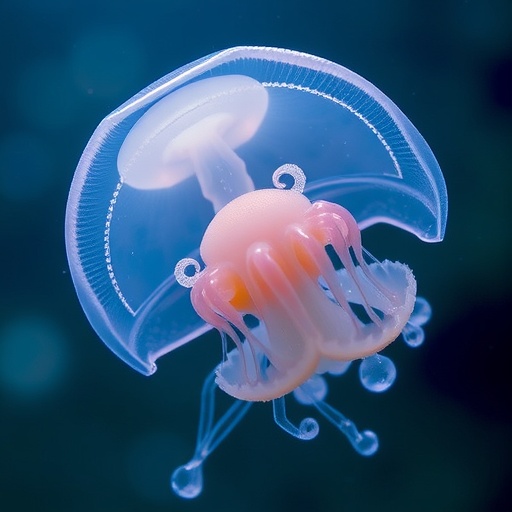In a captivating revelation shedding light on the dynamic shifts occurring in marine ecosystems, a team of student researchers from Tohoku University has identified an unprecedented species of venomous siphonophore within the genus Physalia, renowned commonly as the Portuguese man-of-war. This novel species, hitherto undocumented in the northeastern waters of Japan, signals noteworthy ecological implications in the backdrop of escalating oceanic temperature anomalies and shifting current regimes that characterize contemporary climate change phenomena.
The peer-reviewed study, published on October 30, 2025, in the esteemed journal Frontiers in Marine Science, offers the inaugural taxonomic description of a Physalia species indigenous to the Japanese marine milieu. This formal identification emerges from meticulous morphological assessments coupled with modern phylogenetic analyses, marking a pivotal expansion in the biogeographical understanding of venomous colonial cnidarians.
The discovery commenced serendipitously when Yoshiki Ochiai, a graduate student engaged in unrelated biodiversity surveys within Sendai Bay, encountered an enigmatic, vividly cobalt-colored siphonophore form that diverged conspicuously from known local jellyfish assemblages. Demonstrating scientific acumen and enthusiasm, Ochiai secured a specimen and transported it for comprehensive laboratory examination, setting in motion the investigative sequence leading to species differentiation.
The new species has been christened Physalia mikazuki, a nomenclatural homage referencing the iconic crescent moon adornment on the helmet of Date Masamune, the illustrious feudal lord of Sendai. Professor Cheryl Ames, a lead authority within Tohoku University’s Graduate School of Agricultural Science and the Advanced Institute for Marine Ecosystem Change (WPI-AIMEC), elucidates that bestowing the samurai-inspired epithet captures both the distinct morphological characteristics of the species and its regional cultural context.
Taxonomic classification entailed an arduous process that spanned detailed examination of the species’ intricate siphonophore anatomy. Chanikarn Yongstar, first author on the publication, describes the challenge of discerning phenotypic hallmarks amid the organism’s complex colonial structure, necessitating comparisons with centuries-old biological illustrations and leveraging meticulous morphological scrutiny to delineate P. mikazuki from its congeners.
Prior knowledge posited that within Japanese coastal waters the genus Physalia was represented solely by Physalia utriculus, distributed broadly from Okinawa through Sagami Bay. Nevertheless, the integrative approach of this study, incorporating mitochondrial DNA barcoding and sequence comparison against global molecular databases, revealed co-occurrence and spatial overlap with the newly characterized P. mikazuki. This paradigm shift underscores the importance of genetic tools in resolving cryptic species diversity.
The northernmost sighting of Physalia colonies in Sendai Bay constitutes a remarkable poleward range extension for the genus, challenging previous assumptions of their environmental tolerances. Researchers sought to elucidate the mechanisms underpinning this distributional anomaly by deploying sophisticated computational hydrodynamic models simulating passive particle advection influenced by ocean surface currents specific to the region.
These oceanographic simulations portrayed a plausible dispersal corridor facilitated by the Kuroshio Current, a powerful subtropical gyre known for transporting warm saline waters northward along Japan’s Pacific coast. Notably, recent oceanographic observations have documented an unprecedented northward extension of this current concurrent with elevated sea-surface temperature anomalies. The modeling outcomes suggested that drifting Physalia colonies could feasibly transit from southern habitats near Sagami Bay to the Tohoku coastline, aligning with the spatial detection of the novel species.
Marine ecologist Muhammad Izzat Nugraha anatomized the particle dispersion models, analogizing the process to the release and tracking of buoyant proxies (“beach balls”) subjected to ocean surface flow dynamics over temporal scales extending into months. This innovative approach enabled predictive mapping that effectively “traced” potential pathways for colonial siphonophore movement, corroborating empirical specimen locations.
The ecological significance of this discovery transcends taxonomy. As venomous colonial organisms capable of inflicting severe envenomations via extended tentacles, Physalia species represent both public safety concerns and sentinel indicators of marine environmental change. Continuous monitoring is imperative to inform coastal management strategies, safeguard recreational water users, and enhance predictive ecological models for species distributions in warming oceans.
Furthermore, the identification of P. mikazuki contributes valuable data to broader marine biodiversity inventories and reinforces the imperative of sustained taxonomic vigilance amid anthropogenic climate pressures. The researchers advocate for amplified observational efforts and integrative molecular surveys to delineate real-time responses of marine fauna to fluctuating oceanographic regimes, particularly in temperate to subarctic transition zones.
In acknowledging both the scientific and cultural resonance of their work, the research collective emphasizes the fusion of traditional scholarship, molecular science, and computational oceanography that culminated in this landmark discovery. This multidisciplinary methodology exemplifies an adaptive framework necessary to confront the complexities of marine biodiversity shifts under climate perturbation.
Supporting this cutting-edge investigation, the Advanced Institute for Marine Ecosystem Change (WPI-AIMEC) provided essential funding, while open-access publishing facilitated by Tohoku University’s APC support project ensures widespread dissemination of findings. This unfettered access serves to catalyze further research endeavors and public engagement on marine ecological transformations occurring at the confluence of biological novelty and oceanographic phenomena.
Subject of Research: Discovery and taxonomic description of a new venomous siphonophore species, Physalia mikazuki, expanding biogeographical knowledge and examining ocean current-driven distribution shifts.
Article Title: Researchers in Japan Discover New Jellyfish Species Deserving of a Samurai Warrior Name
News Publication Date: 30-Oct-2025
Web References: doi.org/10.3389/fmars.2025.1653958
Image Credits: ©Tohoku University
Keywords: Biodiversity, Oceanography, Oceans, Marine biology, Ocean currents, Ocean temperature, Marine biodiversity, Species distribution




